Did you know that Asian pears are a type of pear that originated in China? These pears are crisp and crunchy, with a sweetness similar to apples.
Asian pears are often used in salads and as a healthy snack, but they can also be baked or used in sauces and stir-fries.
If you are looking for a tasty and healthy alternative to traditional pears, then Asian pears are worth trying.
However, if you cannot find Asian pears or simply want to try something new, then there are several excellent substitutes that can be used in their place.
In this article, we will take a look at five of the best substitutes for Asian pears so that you can still enjoy all of your favorite recipes even if you can’t find these unique fruits.
What is the Asian Pear?
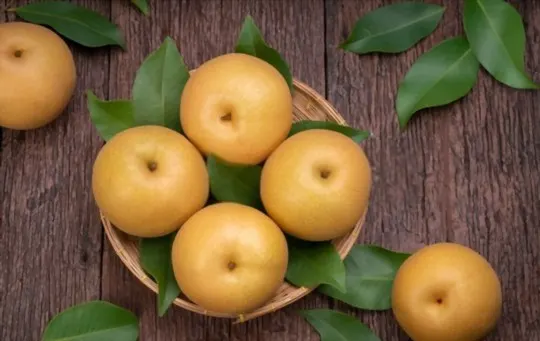
Asian pears are a type of fruit technically classified as a pear, although they have some significant differences from the European pears that many people are more familiar with.
Asian pears are native to East Asia and have been cultivated for thousands of years.
They typically have a round or oval shape and a thin, leathery skin that can range in color from green to yellow to brown.
The flesh of an Asian pear is crisp and juicy, with a sweetness that is similar to that of an apple.
Not only are Asian pears a delicious and healthy snack, but they also have several potential health benefits.
For one, they are a good source of fiber.
Fiber is important for keeping the digestive system healthy and can also help to regulate blood sugar levels.
Additionally, Asian pears contain vitamins and minerals that can promote overall health.
For example, fruits are a good source of Vitamin C, which is essential for immune system function.
Asian pears also contain copper, which is necessary for the production of red blood cells.
When shopping for Asian pears, look for fruits that are firm to the touch and free of blemishes.
Avoid pears that are overly soft or have wrinkled skin, as these may be past their prime.
Asian pears can be eaten fresh or used in salads, stir-fries, and other dishes.
The fruits will keep for up to a week when stored in a cool, dry place.
So, next time you’re at the store, be sure to pick up some Asian pears.
Not only are they delicious, but they may also help you to stay healthy.
The 5 Best Substitutes for Asian Pear
If you can’t find Asian pears at your local grocery store, don’t fret.
There are a variety of other fruits that make excellent substitutes in both sweet and savory dishes.
1 – Anjou Pear
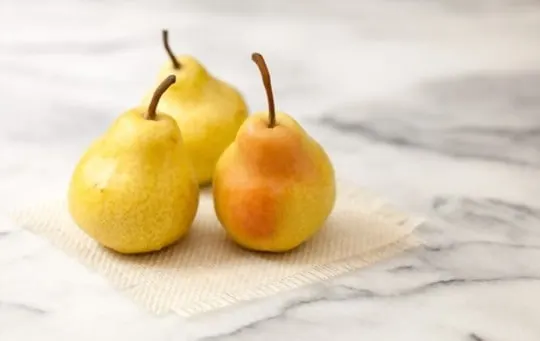
The Anjou pear is a variety of pear that is prized for its sweetness and juiciness.
Originally from France, the Anjou pear is now grown in many parts of the world.
The fruit is large and round, with a thin skin that ranges in color from green to yellow.
Inside, the flesh of the Anjou pear is creamy white and very soft.
This makes it an ideal pear for eating fresh and using in baking and cooking.
The Anjou pear is also popular for canning and preserves, as it holds its shape well when cooked.
Whether you enjoy it fresh, canned or cooked, the Anjou pear is sure to add a touch of sweetness to your day.
2 – Bosc Pear
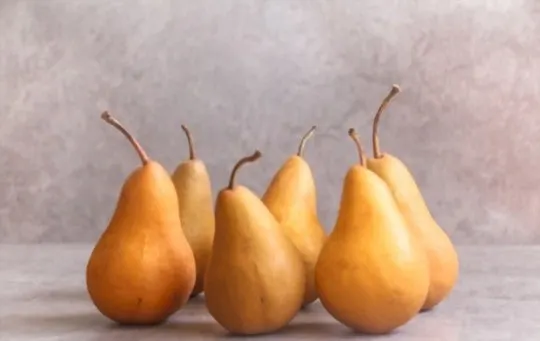
The Bosc pear is a variety of pear known for its long, slender shape and dark brown skin.
Unlike other varieties of pear, the Bosc pear has a firm texture and a sweet yet slightly tart flavor.
Bosc pears are native to Europe and were first introduced to North America in the early 1800s.
Today, Bosc pears are grown throughout the United States and Canada.
When buying Bosc pears, look for fruit that is heavy for its size and that has smooth, unblemished skin.
Avoid pears that are bruised or have soft spots.
Bosc pears can be eaten fresh or used in recipes such as pies, tarts, and salads.
Pair Bosc pears with sweet fruits such as apples or grapes for the best flavor.
3 – Forelle Pear
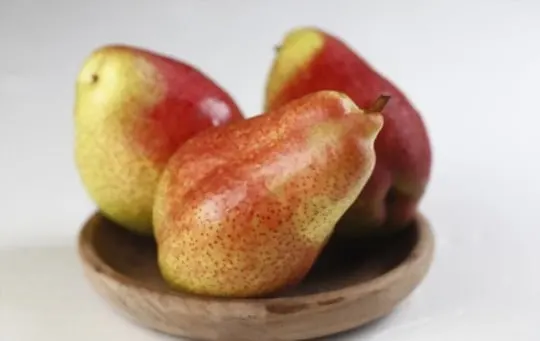
The Forelle pear is a small tart fruit that is native to Europe.
It gets its name from its distinctive shape, which resembles a fish with fins and scales.
The pear is also known for its vibrant red color, which makes it a popular choice for jams and jellies.
Although the Forelle pear is not as sweet as some other varieties, it is still delicious when eaten fresh or used in recipes.
In addition to being a tasty treat, the Forelle pear is also rich in vitamins and minerals.
So whether you enjoy it as a snack or use it in your favorite recipe, the Forelle pear will surely add a little sweetness to your day.
4 – Bartlett Pear
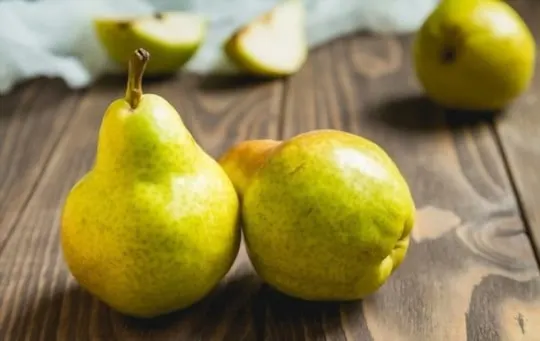
The Bartlett Pear is a popular variety of pear loved for its sweet flavor and crisp texture.
The fruit is medium-sized and has yellow or green skin, with white flesh speckled with small brown seeds.
Bartlett Pears are typically harvested in late summer or early autumn and can be eaten fresh, canned, or used in recipes.
The trees are medium-sized and have dark green leaves.
They are relatively easy to grow and often planted in home gardens or commercial orchards.
Bartlett Pears are a delicious and versatile fruit that can be enjoyed in many different ways.
5 – Fuji Apple
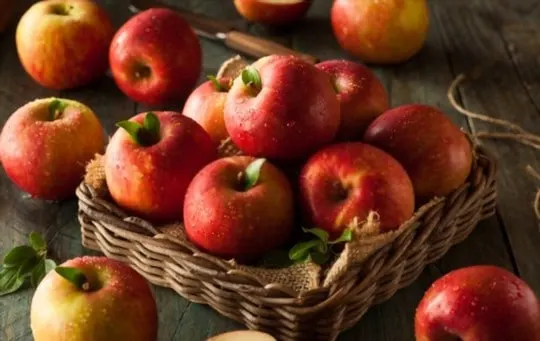
The Fuji apple is a popular variety of apple that was first developed in Japan.
The fruit is large and round, with bright red skin and crisp, white flesh.
Fuji apples are very sweet, with a slightly tart flavor.
They are often used in salads and desserts or simply eaten out of hand as a tasty and healthy snack.
While the Fuji apple is not native to North America, it has become increasingly popular in recent years, thanks to its sweetness and beautiful appearance.
The Fuji is worth trying if you are looking for a delicious and nutritious apple.
Conclusion
In conclusion, there are a few different types of fruit that can be used as substitutes for Asian pears.
These include Anjou pear, Bosc pear, Forelle pear, Bartlett pear, and Fuji apple.
While there may be some slight differences in taste and texture, these fruits can be used interchangeably in recipes calling for Asian pears.
So if you can’t find Asian pears at your local grocery store, don’t worry.
You can still make all your favorite dishes using one of these five substitutes.
So there you have it—the five best substitutes for Asian pear.
Now get out there and start cooking (or baking, or snacking).

Leave a comment